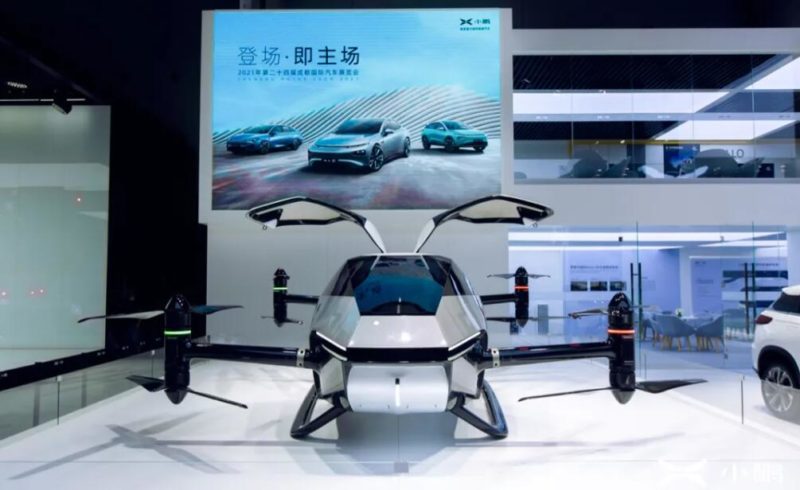A new player in the electric aviation market, Xpeng has introduced a series of electric aircraft, and is currently test flying them. A relative newcomer to the electric vehicle scene, Xpeng is making inroads with a sport utility vehicle (SUV), its P7 sedan, and its aerial projects.
“Xpeng or Xiaopeng Motors, also known as XMotors.ai, is a Chinese electric vehicle manufacturer. The company is headquartered in Guangzhou, with offices in Mountain View, California in the US and is publicly traded on the New York Stock Exchange,” as reported by Wikipedia. Prices in China range from around $23,300 for the G3 to around $50,000 for the P7, claimed to have a range of up to 408 miles. Both are slated to be competitive with comparable Tesla models. The company doesn’t seem to be listing prices for their aerial EVs, though.
The X1 Single Seat Multirotor
Neatly covering any rotor noise with Justin Timberlake, Carey Mulligan, and Stark Sands, Xpeng demonstrates a short hop with a tidy single-seat multirotor not unlike Lift’s Hexa.
eVTOL News reports, “The aircraft has a maximum speed of 72 km/h (45 mph) and a range of 30 km (18.5 miles) or 30 minutes, whichever comes first. The original name of the aircraft was the Kiwigogo T-One (was also written as T-1 and A-1) but as of September 2020, the aircraft’s name has been shortened to Kiwigogo. (And since renamed the X1, apparently) The first flight for the aircraft was June 2018.”
The same source provides these specifications:
- “Aircraft type: eVTOL
- “Piloting: Piloted or autonomous
- “Capacity: 1 passenger
- “Cockpit: Open
- “Maximum speed of 72 km/h (45 mph)
- “Range: 30 km (18.5 miles)
- “Flight time: 30 minutes
- “Cruise altitude: 16-82 feet (5-25 meters)
- “Maximum altitude: 3,000 m (9,650 ft)
- “Maximum take-off weight: 800 kg (1,734 lbs)
- “Propellers: 8 propellers
- “Electric engines: 8 electric motors
- “Electric motor output: 80 kW, each
- “Windows: Front windshield, sides are open
- “Landing gear: Skid type landing gear
- “Safety features: Has multiple redundancy features, advanced flight control to keep the aircraft stable in windy or gusty conditions to ensure safe flight. Distributed Electric Propulsion (DEP), provides safety through redundancy for its passengers and/or cargo. DEP means having multiple propellers and motors on the aircraft so if one or more motors or propellers fail, the other working motors and propellers can safely land the aircraft.”
Eight times 80 kW equals 640 kW total (858 horsepower), which seems a little overwhelming for such a craft. That may account for the gross weight, probably necessary to carry the batteries for a half-hour’s endurance.
A Two-seater with Greater Speed and Endurance
Again, specifications come from eVTOL News:
- “Aircraft type: eVTOL multicopter
- “Piloting: Autonomous
- “Capacity: 2 passengers
- “Maximum speed: 130 km/h (81 mph)
- “Flight Time: 35 minutes
- “Cruise altitude: 300-500 m (984-1,640 ft)
- “Empty weight: 360 kg (794 lb)
- “Maximum takeoff weight: 560 kg (1,235 lb)
- “Propellers: 8 propellers
- “Electric Motors: 8 electric motors
- “Power source: Batteries
- “Fuselage: Carbon fiber composite
- “Windows: Canopy over cockpit
- “Landing gear: Fixed skid landing”
- Safety Features are as described for the X1.
The fifth generation of “flying cars” from Xpeng Huitian, the Voyager X2 is “being tested in extreme environment,” including, “high altitudes over cities like Xining and Yushu, Northwest China’s Qinghai province.”
Empty weight ostensibly includes batteries, making for a somewhat confusing comparison with the single-seater. With two on board, all-up weight is close to Light Sport Aircraft (LSA) restrictions and about 400 pounds less than the X1. It also claims an extra five minutes endurance
Capable of two “driving” modes, manual and autopilot, the “autopilot function can operate an automatic flight according to a predetermined altitude, speed, and flight time along a planned route.
With offices in Silicon Valley, a move toward our shores seems likely. We can hardly wait for the competition to begin and our questions to be answered.


Comments 1
Am really interested on commercialise it in Africa they need it